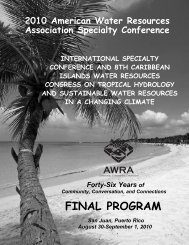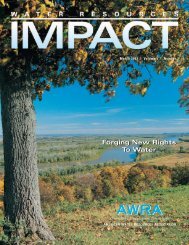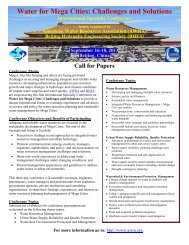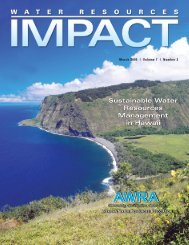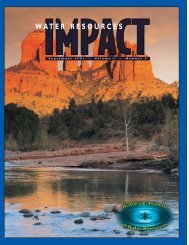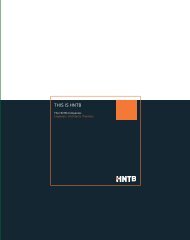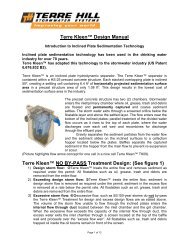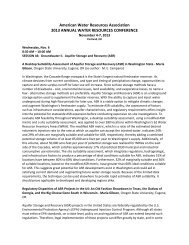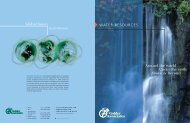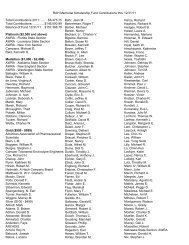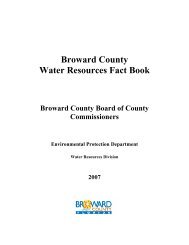N ovember 2 0 0 0 ⢠V olume 2 ⢠N umber 6 - American Water ...
N ovember 2 0 0 0 ⢠V olume 2 ⢠N umber 6 - American Water ...
N ovember 2 0 0 0 ⢠V olume 2 ⢠N umber 6 - American Water ...
You also want an ePaper? Increase the reach of your titles
YUMPU automatically turns print PDFs into web optimized ePapers that Google loves.
The New <strong>Water</strong>shed Tools – Genuine Steel or Chrome-Plated Plastic? . . . cont’d.<br />
professional guesstimates, and the like. We are likely to<br />
see an increasing n<strong>umber</strong> of watershed plans based on<br />
“presumptions of pollution” according to which land uses<br />
are presumed to cause or contribute to specific impairments<br />
– without benefit of monitoring – and are assigned<br />
levels of responsibility per acre or unit of production, by<br />
default.<br />
These defaults may be based purely on “professional<br />
judgment,” but may also reflect the outcomes of limited<br />
field trials and simulations. In either case, such defaults<br />
are no substitute for monitoring. They are almost certain<br />
to falsify reality. As Kelly Redmond argues so convincingly<br />
(Redmond, 2000), “Ecological disturbances – and impacts<br />
on human systems – in many environments often<br />
occur in just minutes or hours . . . and affect the evolution<br />
of those systems for decades or centuries afterwards.<br />
Such typically unpredictable events can only be adequately<br />
captured and quantified by monitoring systems<br />
recording at sufficiently short intervals that such a significant<br />
event does not pass through undetected.”<br />
Charles Slaughter cautions that “landscapes and watershed<br />
are spatially variable and may exhibit highly diverse<br />
characteristics over short horizontal distances.” He<br />
reports that even on a small catchment of 11 acres, two<br />
rain gauges were required to produce an accurate model<br />
(Slaughter, 2000). Thus, rainfall simulations on small<br />
test plots cannot be expected to predict nutrient concentrations<br />
in runoff for an entire farm, let alone entire regions<br />
of the country. Uncritical use of such data will, in<br />
the end, destroy rather than build confidence in watershed<br />
models.<br />
The reviewers of the BASINS model caution that “effective<br />
calibration is still an ‘art’ where multiple parameter<br />
datasets can achieve the same degree of simulation<br />
matching to monitoring data.” Because models contain<br />
many variables, there are an unlimited n<strong>umber</strong> of scenarios<br />
that will yield the same result. If a + b + c = d, an<br />
infinite n<strong>umber</strong> of values can be assigned to a, b, and c<br />
to reach the sum "d." Where “a” is temperature, “b” is<br />
flow, and “c” is nitrate concentration, and so on, with<br />
every known variable represented, it is possible for the<br />
modeler/artist to construct an unlimited n<strong>umber</strong> of scenarios<br />
with the same numeric outcome. The reviewers<br />
question, therefore, whether “a majority of BASINS users<br />
will have sufficient professional judgment and insight to<br />
use the system wisely and to fairly represent the results<br />
to the broad array of TMDL stakeholders.”<br />
Whittemore and Beebe (2000) also worry about what<br />
they term “rogue analyses,” which they regard as “always<br />
possible and even probable in some adversarial situations.”<br />
The public, they observe accurately “is illequipped<br />
to distinguish the good science from inappropriate<br />
analysis when it come to technical watershed assessment<br />
and modeling issues.” With considerable charity,<br />
the reviewers suggest that “most water quality professionals<br />
would acknowledge that these resources are<br />
not infallible and error free.” Hopefully they are right, but<br />
the temptation to pass off a fallible model as a reliable<br />
representation of reality is great and not always resisted.<br />
USGS hydrologist Leonard Konikow, winner of the<br />
<strong>American</strong> Geological Society’s 1997 Meinzer Award for<br />
distinguished contributions to hydrology, along with his<br />
USGS colleague John D. Bredehoeft take the critique of<br />
modeling a step further (Konikow and Bredehoeft, 1992).<br />
They write persuasively about the quandary regulators<br />
face when confronted by the insurmountable obstacles<br />
which lie between them and verifiable scientific conclusions<br />
about the environment. Regulators argue that their<br />
models, if not really faithful to reality, are at least “adequate<br />
representations of the real system.” As Konikow<br />
and Bredehoeft tell it, “Defining what is adequate will, in<br />
the end, be a subjective decision made by the regulator.”<br />
“It is natural,” they write, “for people who apply ...<br />
models, as well as those who make decisions based on<br />
model results, to want assurance that the model is valid<br />
... Case histories of model applications ... illustrate that<br />
calibration produces a nonunique solution and that validation,<br />
per se, is a futile objective. Although models are<br />
definitely valuable tools for analy[sis] ... their predictive<br />
accuracy is limited. The terms ‘validation’ and ‘verification’<br />
are misleading and their use ... should be abandoned<br />
...” Such terms, they object “tend to lend undue<br />
credibility to a process that ... is, in the end, inherently<br />
subjective.”<br />
As Whittemore and Beebe (2000) also suggest, the<br />
modeler can never know which values among all the realworld<br />
parameters were responsible for arriving at a<br />
“good” answer, regardless of how much “good” data are<br />
used. Konikow and Bredehoeft add “The nonuniqueness<br />
of models’ solutions means that a good comparison<br />
can be achieved with an inadequate or erroneous model.”<br />
A “. . . competent and reasonable scientist may declare a<br />
model as validated while another may use the same data<br />
to demonstrate that the model is invalid. In science and<br />
engineering, such an operational definition [‘valid’ or ‘invalid’]<br />
would not appear to be meaningful,” they conclude.<br />
NO SUBSTITUTE FOR THE REAL THING<br />
Models, in other words, cannot be used as a substitute<br />
for knowledge of the real world, and the only reliable<br />
way to attain such knowledge is through intensive, longterm<br />
monitoring. This is an investment in our environment<br />
and our economy that we cannot afford not to<br />
make.<br />
In the last eight years alone, we have spent $1 trillion<br />
for air quality monitoring, but between 1972 and 1990 an<br />
estimated $33 million has been spent on scientific assessment<br />
of our waters. It is time for a true and complete<br />
national water quality inventory. It will take all of 20<br />
years just to make a proper start, and we don’t have a<br />
moment to lose.<br />
LITERATURE CITED<br />
Ator, Scott W., Joel D. Blomquist, John W. Brakebill, Janet M.<br />
Denis, Matthew J. Ferrari, Cherle V. Miller, and H<strong>umber</strong>t Zappia,<br />
1998. <strong>Water</strong> Quality in the Potomac River Basin, Manyand,<br />
Pennsylvania, Virginia, West Virginia, and the District of<br />
Columbia, 1992-96. USGS Circular 1166:27.<br />
V<strong>olume</strong> 2 • N<strong>umber</strong> 6 <strong>Water</strong> Resources IMPACT • 25



